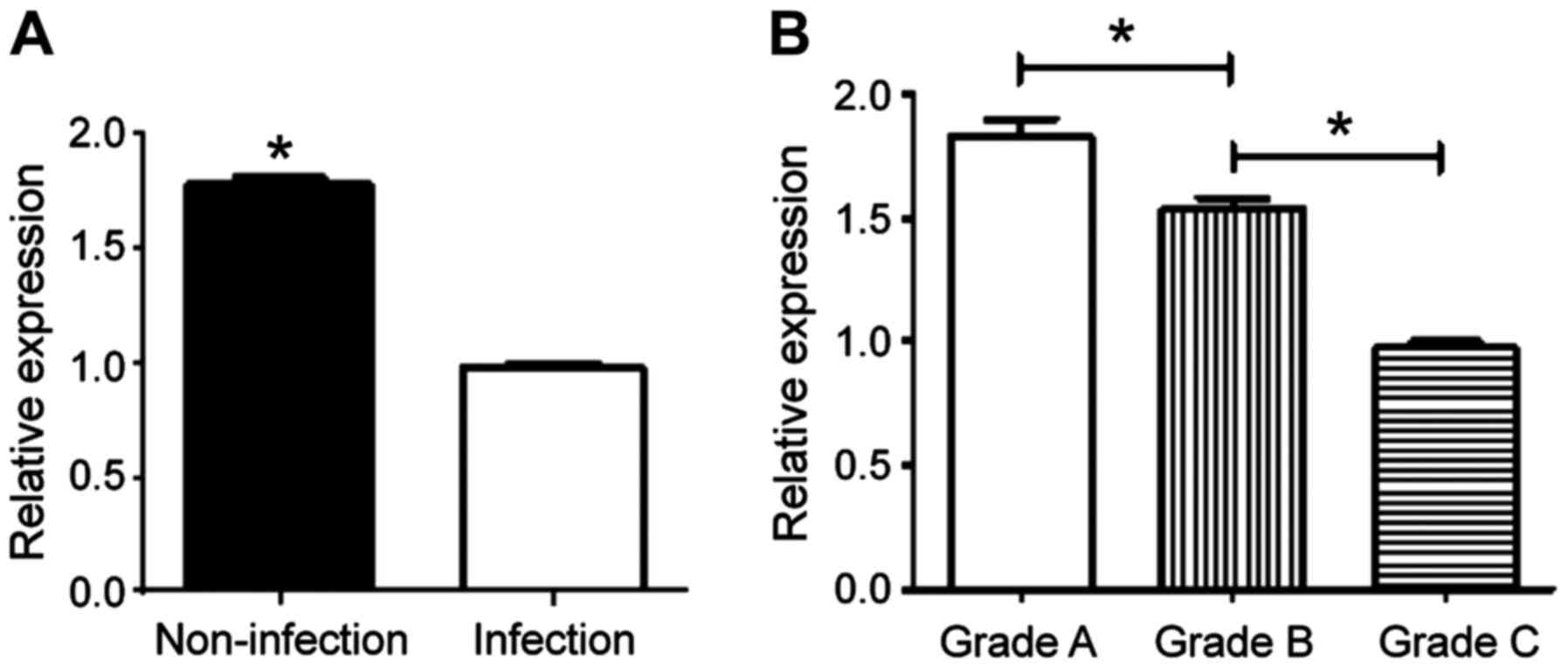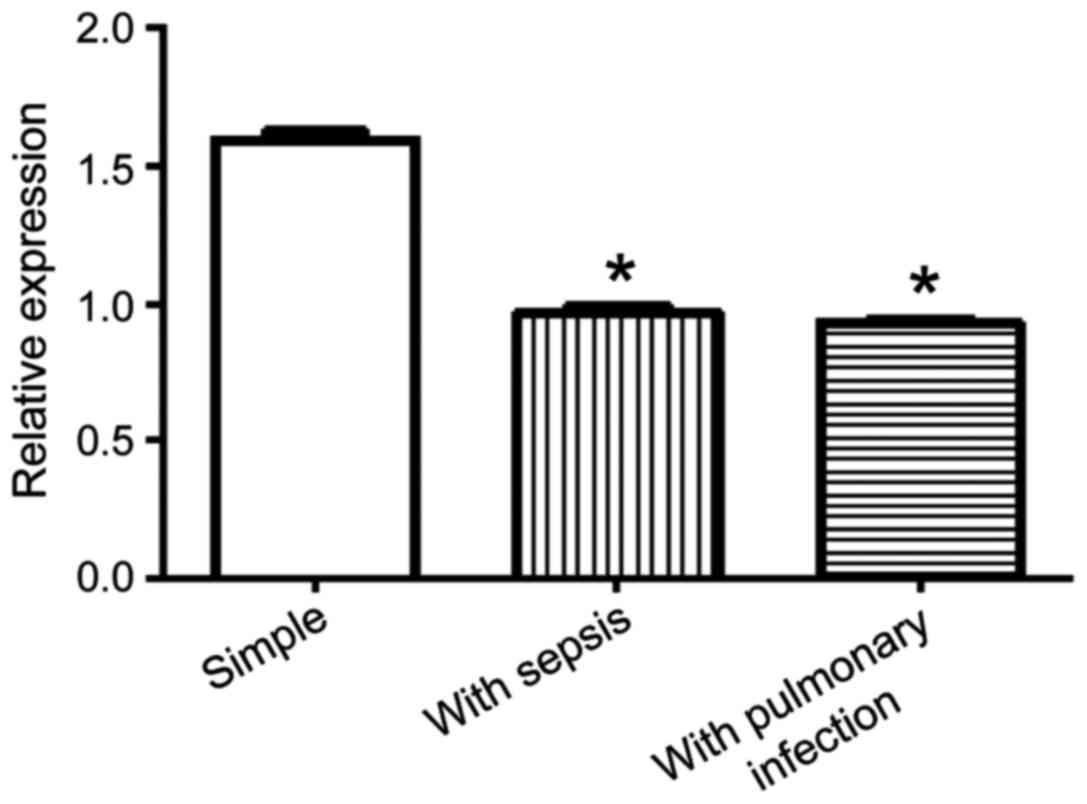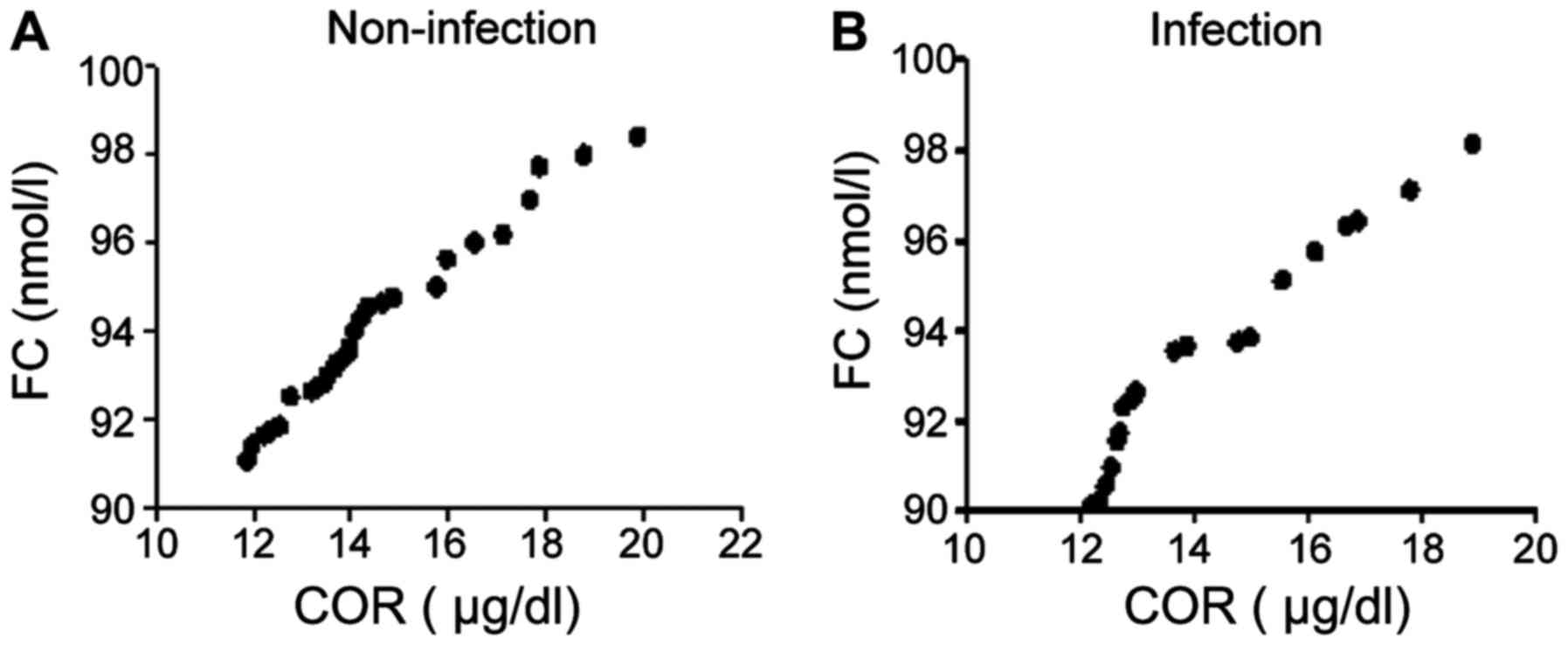Correlation between cortisol levels and concurrent infection for hepatitis B cirrhosis patients and countermeasure analysis
- Authors:
- Published online on: January 11, 2018 https://doi.org/10.3892/etm.2018.5738
- Pages: 2951-2955
-
Copyright: © Zhang et al. This is an open access article distributed under the terms of Creative Commons Attribution License.
Abstract
Introduction
Liver cirrhosis has clinical features such as high incidence, difficult curability and high fatality rate (1). Hepatitis B virus-related cirrhosis is the main type of liver cirrhosis. With the development of hepatitis B disease, liver cirrhosis occurs. According to statistics, for the patients with hepatitis B cirrhosis, the 5-year survival rate is approximately 50%, while the survival rate is lower than 20% in the decompensated period, leading to severe impact on the patients' quality of life of the elderly in China (2,3).
The concurrent infection caused by bacteria and other pathogens is one of the important factors resulting in the difficulties to successfully treat patients with hepatitis B cirrhosis, and can lead to death (4). In recent years, it has been reported that most patients with hepatitis B cirrhosis complicated with infection are accompanied with a decrease of cortiadrenal function, and thereby liver function is indirectly affected, which makes the disease difficult to treat (5–7).
In this study, the cortisol secreted by the adrenal cortex was the focal point, the changes of the infected and uninfected cortisol and serum inflammatory factors of patients with hepatitis B cirrhosis were compared, and the correlation between cortisol (COR) and concurrent infection as well as the countermeasures were analyzed.
Materials and methods
Materials
According to the criteria of the Guideline of Prevention and Treatment for Chronic hepatitis B (2010 version), 86 patients who were diagnosed and treated in the Beijing YouAn Hospital from March 2014 to March 2017 were selected as the non-infection group. This group comprised 58 males and 28 females, aged 25–72 years, with an average age of 54.32±15.41 years. According to the Child-Pugh grade, there were 7 cases with grade A, 38 cases with grade B and 41 cases with grade C. Thirty-two cases of patients were included in the infection group, including 21 males and 11 females aged 24–73 years, with an average age of 55.14±16.03 years. There were 2 cases with grade A, 14 cases with grade B and 16 cases with grade C. Of the 32 cases, 14 cases had simple abdominal infection, 10 cases had abdominal infection complicated with sepsis, and 8 cases had abdominal infection complicated with pulmonary infection.
Exclusion criteria were: i) Patients with other virus infections except HBV; ii) patients with non-alcoholic steatohepatitis, tumor, alcoholic liver disease, cardio-cerebrovascular disease and other major diseases; iii) patients with abnormal adrenal cortex function and any patients who had taken drugs affecting the secretion of cortisol within the last six months.
The differences were not statistically significant regarding age, sex, weight, disease grading and other indexes between the two groups of patients (P>0.05), and thus comparable.
This study was approved by the Hospital Ethics Committee of the Beijing YouAn Hospital (Beijing, China), and made an introduction to the selected patients to ensure that informed consent was signed by them and that they were fully informed.
Reagents
COR chemiluminescence kit (Beckman Coulter, Brea, CA, USA), cortisol binding globulin (CBG) enzyme-linked immunosorbent assay (ELISA) kit (Shanghai Jiang Lai Biotechnology Co., Ltd., Shanghai, China), TRIzol (Thermo Fisher Scientific, Waltham, MA, USA), chloroform, isopropanol (Beijing Chemical Factory, Beijing, China), moloney murine leukemia virus (M-MLV) reverse transcriptase, DNase I (both from Thermo Fisher Scientific), SYBR® Premix Ex Taq™ II (Takara, Dalian, China), and synthetic primers (BGI Genomics, Shenzhen, Guangdong, China) were used in the present study.
Blood routine test
Fasting venous blood (15 ml) was collected from all the patients in the morning, and 7 ml was used in the tests for related inflammatory indexes using a Roche C501 automatic biochemical analyzer (Roche Diagnostics, Basel, Switzerland) including white blood cells (WBC), neutrophils, procalcitonin (PCT), endotoxin and C-reactive protein (CRP).
Detection of cortisol concentration
The collected 7 ml fasting venous blood was centrifuged at 1,300 g/min for 15 min at 4°C in order to collect serum. The concentrations of COR and CBG in the serum were measured by corresponding kits. The concentration of free cortisol (FC) was calculated using the Coolens formula: FC concentration (mmol/l) = Z2 + 0.122c) 1/2-Z; and the coefficient Z was calculated, Z=0.0167+0.182 (T-C), while T was the concentration of COR, and C was the concentration of CBG (8).
mRNA expression detection of CBG gene
RNA was extracted from 1 ml whole blood by TRIzol. The procedure was strictly performed as per the protocol following the instructions, and the concentration was measured. RNA (1µg) was taken to be used for reverse transcription reaction by reverse transcriptase kit to obtain cDNA. The concentration of cDNA was adjusted, and the levels of mRNA and relative expression of different groups were measured using Bio-Rad CFX 96 PCR (Hercules, CA, USA) instrument in accordance with the instructions of the SYBR® Premix Ex Taq™ II kit. The corresponding primer sequences are shown in Table I (9).
Statistical analysis
Statistical Product and Service Solutions (SPSS) 19.0 (Hangzhou NewGrand Software Co., Ltd., Hangzhou, China) was used for data processing. Measurement data are shown as mean ± SD, and were detected by student's t-test. The Kruskal-Wallis test was used for the enumeration data and multiple comparisons (Tables I and II). Analysis of variance was performed, and then pairwise comparison. Pearsons test was used for the correlation analysis between factors. P<0.05 was considered statistically significant (10).
Table II.Comparisons of cortisol levels for the three Child-Pugh grades in the two groups, mean ± SD. |
Results
Comparisons of cortisol levels for the three Child-Pugh grades in the two groups
The concentrations of COR and CBG decreased with the increase of Child-Pugh grades in the infection and non-infection groups, and the differences were statistically significant (P<0.05). The concentrations of COR, CBG and FC at the same grade in the non-infection group were higher than those in the infection group (P<0.05) (Table II). The relative expression of CBG was detected by RT-qPCR, which also showed that grade A > grade B > grade C (P<0.05), and non-infection group > infection group (P<0.05) (Fig. 1).
Comparisons of cortisol levels among different infection types in the infection group
The concentrations of COR, CBG and FC for abdominal infections complicated with sepsis or pulmonary infection were lower than those for simple abdominal infection (Table III). The relative expression of CBG was detected by RT-qPCR, which showed that the group of abdominal infection complicated with sepsis and the group of abdominal infection complicated with pulmonary infection were lower than the group of simple abdominal infection (P<0.05) (Fig. 2).
Table III.Comparisons of cortisol levels among different infection types in the infection group (mean ± SD). |
Comparisons of related infection indexes between the two groups
The values of WBC, neutrophils, CRP, PCT and endotoxin in the infection group were higher than those in the non-infection group, and the differences were statistically significant (P<0.05) (Table IV).
Correlation analysis of cortisol and related infection indexes
COR, CGB and FC were negatively correlated with such indexes as WBC, neutrophils, CRP, PCT and endotoxin. The specific Pearsons coefficients are shown in Table V.
Correlation analysis of COR and FC
The r value of COR and FC in the non-infection group was 0.678, while that of of COR and FC in the infection group was 0.787; infection group was positively correlated with non-infection group, and COR was positively correlated with FC (Fig. 3).
Discussion
Hepatitis induced by HBV is one of the most common forms of hepatitis induced by various viruses. Liver cirrhosis caused by this is one of the major diseases in the world. Liver cirrhosis is commonly complicated with infection, liver ascites and liver cancer (11). Infection is the common complication in liver cirrhosis. Liver cirrhosis complicated with infection often has long recovery time and poor prognostic result, and the mortality rate is 60% (12). Cortisol, also known as hydrocortisone and which is produced by the adrenal gland, mainly exists in the form of binding state and free state. Cortisol has a particularly important effect in controlling mood and health, immune cells and inflammation, connection between blood vessel and blood pressure, as well as maintaining bones, muscles, skin and other organs. Cortisol generally maintains the stability of blood pressure and controls excessive inflammation in the case of pressure state (13,14).
Cirrhosis can be divided into grade A, B and C according to Child-Pugh score from low to high in accordance with its development degree. Especially in later period, the secretion of COR often becomes abnormal, which is largely related to the synthesis and expression of CBG being affected (15,16). In this study, the results showed that the concentrations of COR and CBG decreased with the increase of Child-Pugh grade in either the infection group or non-infection group, and the differences were statistically significant (P<0.05). The relative expression of CBG was detected by RT-qPCR, which showed that: grade A > grade B > grade C (P<0.05). Previous findings have shown that 50–70% of the patients suffering from shock due to cirrhosis combined with infection have adrenal insufficiency, and the damaged adrenal cortical function is bound to affect the level of cortisol in vivo (17). In this study, the results also verified that the concentrations of COR, CBG and FC in the infection group were lower than those in the non-infection group whether on the whole or at the same Child-Pugh grade, and RT-qPCR also confirmed that the expression of CBG gene in the infection group was lower than that in the non-infection group, which was consistent with the findings of Hamrahian et al, who identified that, the expression of CBG gene declined rapidly with the deepening of infection extent (18).
This study also showed that the concentrations of COR, CBG and FC for abdominal infection complicated with sepsis or pulmonary infection were lower than those for simple abdominal infection (P<0.05). The relative expression of CBG was detected by RT-qPCR showing that the group of abdominal infection complicated with sepsis or pulmonary infection were lower than the simple abdominal infection (P<0.05). The results suggests that different infection sites and types can also lead to the decrease of the cortisol level in vivo, especially for more than two concurrent infections, which may be greatly associated with that of more serious infection. Thus, the metastasis of abdominal infection to infect other organs exacerbates the disease.
WBC, neutrophil percentage, CRP, PCT and endotoxin are the most common and sensitive indexes used to measure infection and the most intuitive indexes for infection extent of blood routine at present, and their elevated degree is directly proportional to disease degree of inflammation (19). The present study also verified that the above indexes of the hepatitis B cirrhosis patients complicated with infection were higher than those of the hepatitis B cirrhosis patients without infection. In addition COR, CGB and FC were negatively correlated with such indexes as WBC, neutrophils, CRP, PCT and endotoxin by further study for the correlation between infection indexes and cortisol. Results show that the cortisol levels of hepatitis B cirrhosis patients are significantly correlated whether infected or not, and grades of condition and infection types can be used as sensitive indexes to control hepatitis B cirrhosis infection.
In conclusion, the content of cortisol in vivo can be used as an important index to treat and prevent infection. Therefore, to reduce the probability of infection, grading of hepatitis B cirrhosis should be predicted by the detection of cortisol concentrations. Medical treatment should be taken as early as possible according to different disease grades, and nursing measures should be reinforced. Adrenocortical function should be improved, and the cortisol level should be kept at a reasonable range, in order to indirectly reduce the occurrence of infection. In addition, nursing care for cirrhosis patients should be enhanced, in order to reduce the occurrence rates of psychological fear and unforeseen circumstances.
Competing interests
The authors declare that they have no competing interests.
References
|
Chen GC, Yu T, Min XH, Zhao LN, Qing Q, Yuan YH, Su H, Zhan J, Huang KH and Chen QK: Prognosis of 153 patients with decompensated hepatitis B virus-related cirrhosis is improved after 3-year continuous lamivudine treatment. Chin Med J (Engl). 126:1538–1543. 2013.PubMed/NCBI | |
|
Lv GC, Yao JM, Yang YD, Zheng L, Sheng JF, Chen Y and Li LJ: Efficacy of combined therapy in patients with hepatitis B virus-related decompensated cirrhosis. World J Gastroenterol. 19:3481–3486. 2013. View Article : Google Scholar : PubMed/NCBI | |
|
Zhou YM, Zhang XF, Li B, Sui CJ and Yang JM: Prognosis after resection of hepatitis B virus-related hepatocellular carcinoma originating from non-cirrhotic liver. Ann Surg Oncol. 21:2406–2412. 2014. View Article : Google Scholar : PubMed/NCBI | |
|
Ming D, Yu X, Guo R, Deng Y, Li J, Lin C, Su M, Lin Z and Su Z: Elevated TGF-β1/IL-31 pathway is associated with the disease severity of hepatitis B virus-related liver cirrhosis. Viral Immunol. 28:209–216. 2015. View Article : Google Scholar : PubMed/NCBI | |
|
Sun LL, Li YH, Chen F, Wang S and Shi H: Study on correlation between liver ultrasonic appearance of patients with chronic hepatitis B and cirrhosis and hydrothorax. Eur Rev Med Pharmacol Sci. 20:50322016.PubMed/NCBI | |
|
Srivastava M, Rungta S, Dixit VK, Shukla SK, Singh TB and Jain AK: Predictors of survival in hepatitis B virus related decompensated cirrhosis on tenofovir therapy: An Indian perspective. Antiviral Res. 100:300–305. 2013. View Article : Google Scholar : PubMed/NCBI | |
|
Wang N, Cao Y, Song W, He K, Li T, Wang J, Xu B, Si HY, Hu CJ and Li AL: Serum peptide pattern that differentially diagnoses hepatitis B virus-related hepatocellular carcinoma from liver cirrhosis. J Gastroenterol Hepatol. 29:1544–1550. 2014. View Article : Google Scholar : PubMed/NCBI | |
|
Öcal S, Korkmaz M, Harmancı Ö, Ensaroğlu F, Akdur A, Selçuk H, Moray G and Haberal M: Hepatitis B- and hepatitis D-virus-related liver transplant: Single-center data. Exp Clin Transplant. 13 Suppl 1:133–138. 2015.PubMed/NCBI | |
|
Niro GA, Ippolito AM, Fontana R, Valvano MR, Gioffreda D, Iacobellis A, Merla A, Durazzo M, Lotti G, Di Mauro L, et al: Long-term outcome of hepatitis B virus-related chronic hepatitis under protracted nucleos(t)ide analogues. J Viral Hepat. 20:502–509. 2013. View Article : Google Scholar : PubMed/NCBI | |
|
Wu ZW, Lu HF, Wu J, Zuo J, Chen P, Sheng JF, Zheng SS and Li LJ: Assessment of the fecal lactobacilli population in patients with hepatitis B virus-related decompensated cirrhosis and hepatitis B cirrhosis treated with liver transplant. Microb Ecol. 63:929–937. 2012. View Article : Google Scholar : PubMed/NCBI | |
|
Kim IS, Mun JI, Koo JH, Kang CJ, Bak JK, Cheong JY and Cho SW: Entecavir therapy for patients with hepatitis B virus-related decompensated cirrhosis. Korean J Gastroenterol. 59:224–231. 2012. View Article : Google Scholar : PubMed/NCBI | |
|
Zhou J, Yu L, Gao X, Hu J, Wang J, Dai Z, Wang JF, Zhang Z, Lu S, Huang X, et al: Plasma microRNA panel to diagnose hepatitis B virus-related hepatocellular carcinoma. J Clin Oncol. 29:4781–4788. 2011. View Article : Google Scholar : PubMed/NCBI | |
|
Sun Y, Lu Y, Xie L, Deng Y, Li S and Qin X: Interferon gamma polymorphisms and hepatitis B virus-related liver cirrhosis risk in a Chinese population. Cancer Cell Int. 15:352015. View Article : Google Scholar : PubMed/NCBI | |
|
Saichan X, Wei C, Qinglong F, Jun W and Lei X: Plasma cortisol as a noninvasive biomarker to assess severity and prognosis of patients with craniocerebral injury. Eur Rev Med Pharmacol Sci. 20:3835–3838. 2016.PubMed/NCBI | |
|
Karra VK, Gumma PK, Chowdhury SJ, Ruttala R, Polipalli SK, Chakravarti A and Kar P: IL-18 polymorphisms in hepatitis B virus related liver disease. Cytokine. 73:277–282. 2015. View Article : Google Scholar : PubMed/NCBI | |
|
Bae JS, Kim JH, Pasaje CF, Cheong HS, Lee TH, Koh IS, Lee HS, Kim YJ and Shin HD: Association study of genetic variations in microRNAs with the risk of hepatitis B-related liver diseases. Dig Liver Dis. 44:849–854. 2012. View Article : Google Scholar : PubMed/NCBI | |
|
Chu CM and Liaw YF: Hepatitis B virus-related cirrhosis: Natural history and treatment. Semin Liver Dis. 26:142–152. 2006. View Article : Google Scholar : PubMed/NCBI | |
|
Hamrahian AH, Oseni TS and Arafah BM: Measurements ofserum free cortisol in critically ill patients. N EnglJ Med. 350:1629–1638. 2004. View Article : Google Scholar | |
|
Bárcena R, Domínguez-Antonaya M, López-Sanromán A, Martínez-Turnes A, Urman J, del Campo S and Moreno N: Lamivudine therapy of hepatitis B virus-related liver disease: Cirrhosis, post-transplantation recurrence, and de novo infection. Transplant Proc. 31:pp. 2457–2458. 1999; View Article : Google Scholar : PubMed/NCBI |












